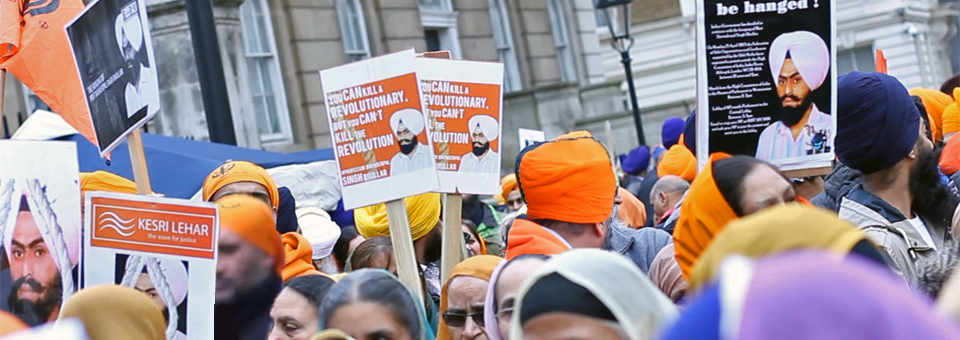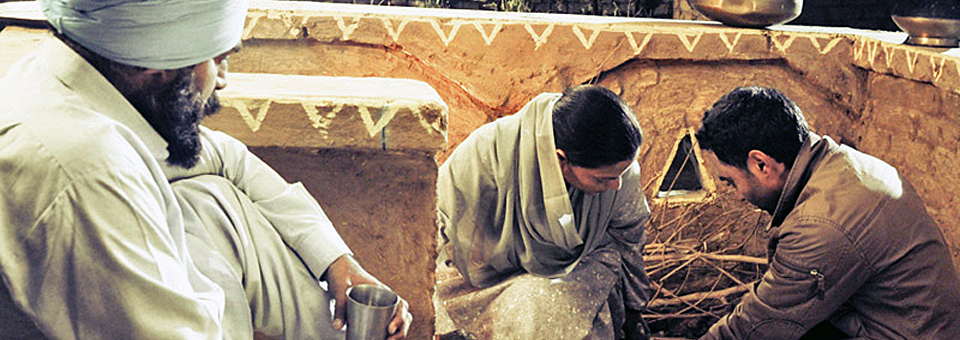Since news broke of Professor Davinderpal Singh Bhullar’s impending execution, Sikhs have been protesting in central London. Over the last week I have taken the opportunity to meet and speak with the protesters in person at different times of the day, from when hundreds gathered outside the High Commission of India last Monday lunchtime, to the conclusion of kirtan after midnight, in the space they have made their own on Whitehall. Initially I was dubious about what this protest would achieve as it appeared to be like so many others, a mere temporary act of protest on a single day. But over a week later and showing no signs of dispersing, these Sikh protesters indicate that in the UK at least, the community is now dedicated to the cause of affecting real change.
The protesters I met with have a real sense that they are actively doing something to make a difference. At their pitch opposite the entrance to Downing Street, there are posters on display, leaflets being handed out to passers by, and a steady rotation of willing (and vocal) volunteers. After speaking thoroughly with half a dozen protesters who have been permanent fixtures at the site on a daily basis, I started to learn why this protest was different to those of our recent past. Firstly, following on from the release of the feature film ‘Sadda Haq’ and the #iPledgeOrange movement of last year, there is a renewed understanding that these are current-day problems that we cannot simply pick up and drop. In the west our lives go on and we become complacent, but in Punjab these problems are a reality witnessed on a daily basis. Secondly, there were no leaders or organisations present. Every individual that I spoke to was just that – an individual. Moreover, I was told that at least two Sikh bodies had suggested the protest be brought to an end early in the week; they were politely told that it was not their protest but one held in the name of the Sangat (the wider Sikh congregation). Members of those bodies have not returned since.
Sikh protests and demonstrations have become increasingly well attended here in the UK and it’s easy to see why. Physically expressing energy brings with it a sense of achievement and although protests are not without value as a contribution to any movement, in my opinion they don’t take us closer to resolving the immense problems facing the Punjab. Public protest is a temporary action, largely ineffective on foreign soil and resource hungry. The latter is what concerns me most; at the gathering last Monday, I saw hundreds of passionate Sikhs, men and women who have the potential to manifest Guru Nanak’s vision on Earth, reduced to the ignominy of sloganeering and marching. It is said that the sight of the Khalsa once stemmed the flow of the mighty Indus river at Attock; last Monday buses merely slalomed through Westminster as the country kept on ticking.
But with the protesters who have continued throughout the week and stood firm, one cannot so easily disregard the endeavour, even if we question the fruitful produce that can grow from it. In that regard, I was surprised to find that many of those protesters I spoke with at length asked the same question that I originally intended to answer by writing this article: what more can we do? Despite their commitment and passion, even the unflinching protesters are resigned to the fact that what can come through these means is limited and more importantly that some day this protest will come to an end, even if it is weeks, months or years from now.
So what am I suggesting the Sikh response should be the next time we all wake up to an injustice or atrocity in the Punjab? Well, two factors must shape our manifesto. Firstly, we must not be reactive in nature. As with the Rajoana case last year, our agenda is being dictated by events outside of our control and no change for good will rise from a people on the back foot. Response to these happenings is necessary, but it should only be one side of our coin; we must tell our story, in our own way and in our own time. Secondly, the Panth’s plan of action must be well thought out. A considered stratagem need not be designed by all Sikh organisations in collaboration, or indeed by any two Sikhs in partnership; I don’t even believe that it must be followed through by the entire Panth. But it must be for the long term and adhere to the desires of those who deliver it.
Our way forward is no singular plan; instead it is a multi-faceted road laden with a range of vehicles all with a broadly similar destination. What is the way ahead for me, might not be for some, but then again it might be for another. Where you see something positive that you can add value to, you must engage and support. I have volunteered for one Sikh organisation for over 15 years because I believe it to be making the right strides and it has been the single most important factor in my development as a Sikh. Where you find no positive force, look harder and ask around, but if it doesn’t exist make it happen. That is how I founded this site, Naujawani.com, because I could not see a professional media outlet and hub for presenting news, views and entertainment to the Sikh World. As I have said many times before on these pages, Naujawani.com was established with a 10 year plan to become a fully operational media outlet – television, film and radio cannot be borne overnight; where it is incompetency will result. But I am overwhelmed by the assistance and offers of support we are sent every day by visitors to the site who see where we are going.
That aside, what should the individual Sikh do? Many Sikhs reading this will feel that they already contribute in some way to an organisation, body or local community, but know that it is not enough. Before the sunrise of the Sikh spring, you must ask yourself a question: am I a Sikh? A Sikh is a follower of the teachings of Guru Nanak, one who learns from the eternal House of the Guru as immortalised in the Guru Granth Sahib. The Sikh’s role is to read, listen and contemplate what the Guru says; following discussion, deliberation and comprehension, the Sikh can then put those teachings into practice and attain a higher state of consciousness to the benefit of all mankind. Yet amongst the vast majority, this is the opposite of what a ‘Sikh’ does today. Those who step onto the path all too often rely far too much on the direction of others and we as a community are worse off for it. We allow ourselves to ride pillion passenger, instead of taking control and experiencing the path. Precious few are those who have made Sikhi their way of life and not just their ‘religion’. And in these times where the Guru is accessible virtually anywhere and everywhere that is inexcusable.
Still asking what should we do? Enrol on a Sikh Studies course; you will find that the answers we look for today have been offered yesterday and before. Join a Sikh study circle or start one of your own; you will read articles, essays and books and then discuss their content with your fellow Sikhs to the benefit of you all. Become an ambassador for the House of Guru Nanak by engaging with the wider World in everyday life keeping the values you are gaining at the heart of how you present yourself. Attend plays, hear poetry, watch films, take in art and listen to live music. Share those experiences with those on the path and allow it to enrich your life by helping you to ask the questions that really matter. If you feed your brain – consume knowledge and deliberate with others – then you can test yourself by reviewing what is going on in the World and analysing it. In time, you can make history by using your new-found abilities to affect change in real time. This is the path of the Sikh. What happens next is up to you.






